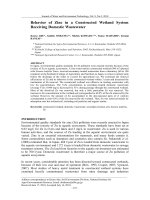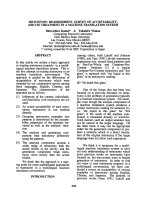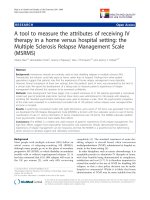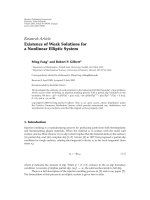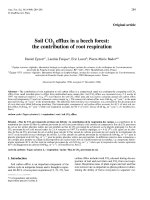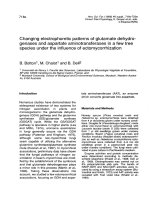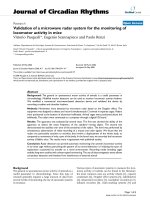Parametric resonance of 4th order in a nonlinear vibrating system under the influence of frictions
Bạn đang xem bản rút gọn của tài liệu. Xem và tải ngay bản đầy đủ của tài liệu tại đây (1.95 MB, 6 trang )
Journal o f Technic a l P hysics, 17. 4. 435 44 0, 1976.
Polish A c a de m y o f S c iences, In stitute o f F undam ental Technological Research, H’ar.idfiwa.
PA RA M ETRIC R ESONANCE O F 4th ORDER IN A NO NLINEA R VIBRATING
SY STEM UNDER TH E INFLUENCE O F FRICTION S
NGUYEN VAN DAO (HANOI)
I. Introduction
Among the parameters having considerable influence on parametric oscillations it
is worth mentioning the nonlinear frictions [I]. This paper is concerned with the study of
the influence of some kinds of frictions on the nonlinear oscillations described by the
equation with the cubic term at modulation depth:
(1.1) X -f (0 2x 4- eịc.x 4- (i.Y3) COS yt -f fa.\3 + eR(.x, x) = 0,
in the resonant zone of 4th order:
(1.2) y 2 = 1 6 (f0 2 — e/i),
where e9 (O, c, d, a are constants, R(.x, .v) is a function characterizing the frictions con
sidered.
It h as turned o u t that th e param etric osc illa tio n s and their stab ility in the r esonan t
zone (1.2) are essentially dependent on the friction forces. But, the resonant curves in the
ca ses o f lin ear fr ictio n , dry frictio n an d th e turb u lent o n e are not different in qu a lity.
2. General Investigation
We shall find the solution of Eq. (1.1) in the form
X = ứsinớ,
(2.1) V = ỚCOSỠ,
0 = r t+ v ,
where a and y} are new unknown variables which will be determined later. By substituting
(2.1) into (1.1) and transforming it, we obtain the following equations for a and ip:
ya = — 4e[Ax + (c.Y4-i/.Y3)COSy/ -f (XX2 -I- R(x, i)]cosỡ,
yaỳỉ = 48 [Ax + (cx + dx3)COS yt -f- (XX3 4- R(x, x)] sin 0,
436
Nguyen van Dao
which is the standard form for the method of averaging [2]. Following this method
let
2 3 a = + v v 0 ,
V = + V*- 0 ,
where Ỡ* and y* satisfy (he averaged equations:
= — 4e
(2.4)
G(ơ > y) ~ s*n 4y-
ỵơỳ; = 4t'
here for short we omit the subscript (*) and
y— a-f ~ art3 -f P(a, y ) + rt3 COS4y»
2 8 16
(2.5)
2n
G(a,y) = -~~
Ị
cosớ* /?Ịí7S Ìiiỡ, ^ tfcosỡjí/ớ,
In
P(a,y) = I sin0 • / W ứ s i n ỡ , flcosOjrfO.
0
The functions /1 and (Ị) in (2.3) will be obtained from the right-hand sides of (2.2) (sec
Sect. 3).
The steady-state response can be found by setting a, xp equal to zero in equations
(2.4). Thus:
d , .
"16 ^oSin4v*o = G(a0, y),
(2 .6)
d d 3
- a0 cos 4 Vo = y f l o + y ««0 + ^(«0, v) ■
Eliminating the phase 7*0 yields
(2.7)
where
(2 .8)
W(a0 ,y) - G2(a0, }') +
W'teo, ỳ) = 0 ,
■ /1 3
2 a° + 8 0 + (a° ’
(16)* •
To study the stability of stationary oscillations, the variational equations based on tlie
Stationary solution will be considered. By setting in (2.4)
a = ơ0 + ôa, y) ~ ipo + ồyỉ,
where Ỗa and ôy) are small perturbations, and using the steady-state equations (2.6),
we have
d
(2.9)
y () a = 4e
cit
ya0 - ỗf = 4e
r", \ , 3í/ứổ ■ ,
G («0 . y) + - s i n 4Vo
/I 9 2 n//_ . 3í/«ổ .
y + “ Oftfo + p (a0, 7 ) + ~ - cos4^o
d a l . . ,1
ô a ~ sin4yv'V’|\
here a prime denotes partial differentiation with respect to o0.
The characteristic equation of the system (2.9) is of the form:
Parametric resonance o f 4th order in nonlinear vibrating system 437
The stability condition is given by the Routh-Hurwitz criterion, that is
0 dw
In Fig. I the branches of unstable solution are represented by dotted lines in which
the conditions (2.10) are Violated. It should also be noted that the boundary between the
stable and unstable regions shows the locus of vertical tangency (dw/da0 — 0) with the
resonant curves.
3. Linear Friction
Let us consider the case
(3 .1 ) R(x, x) = hx,
where h is a positive constant. Ill this case the equations (2.4) become
I h ‘to2 : A \
ya = e a \- y y + - 4 - sin4yj I,
(3.2)
L i 3 2 da2 _ A \
yaỹ) = ea 12/1 -f — <xa H— - COS 4y)j,
and the relation (2.7) is of the form:
(3.3) (/?2- Z ) > ắ + 2/?(l-/<2K + ( l - /u2)2 + / / V = 0,
in which
/1 y n ed Ũ 3ea „ e/l
(3 .4 ) /Í = -7— , D = 82 , H = •
4o> 8coz 4 o r 0)
From (3.3), we obtain
(3.5) flg = —
[ P f r * -
1)+ Ị '7 ;> ( 1 - V )2 i(/>j - m v | -
It should be pointed out that the most interesting case is that for which p2 > D2.
This case is shown in Fig. 1 by plotting the Eq. (3.5) for ft = ±1 • 10“3, D = 3 • 10~3
with various values of h:H = 0 (straight lines “0”), H 2 — 5* 10~4 (curve 1), H 2 — 10~3
(curve 2).
To find the refinement of the first approximation we represent (2.2) in the following
expanded form
da 16e
r
ha da3
8 16
. . Atf a I A a
sin4^ 4- ycos2ớ + M -1- 2 1
438
Nguyen van Dao
( r + ^2 j si 11 (2Ơ — 4 v ) — sill4Ỡ + “ !<• + ‘y - j s in (6 0 - 4 y ) - ^ sin (8 fl-4 y > )
iA/j 16e
(10 = V 2 '
JZ-G+ 0 aơ3+ , cos4ĩ/»— ( I -f atf2)cos20+ 7 ơysin2ớ
z o 1D 2 8
— 4 " (r + ^ứ2) cos(20-4y)-ị- g ếJ3cos4ỡ + 2 Ịr + 4 í/ứ2| cos(40-4y)
— ^ (c + <Vtf2)cos(6ỡ—.4y) + rá*r-cos(8ớ — 4?/>)
Fig. I.
Since Ơ and V’ do not vary very rapidly, we shall integrate the right-hand sides of (3.6)
as if a and w were constant. We thus obtain
n -n - ì6f
(3.7) a = a0
-
y
16e
v> = Vo +
ysin20 — + y o ^ jc os 2 0 + - y |c + I COS (2 0 -% ,)
+ ~ cỏ cos 40— |c + d~~j cos(60-4y>„) + cos(80-4y>o)
a y2- - y COS 2 0 - (zl + 0íữẳ)sin2ớ- ơ-° (c + í/ữẩ)sin(20-4yio)
+ ~ ứẵ sin4ớ + — ■ Ịc + sin(4ỡ - 4y>o) - -|ị- (c + í/ữẳ) sin (60 - 4 Vo)
+ -^ - s in (8 ớ -4 Vo)
Nguyen van Dao
439
The new refined first approximation will be given by
.8) -V = asin i^r- t + rp).
4
fter some simple calculations this leads to
.9) -X = ứ0sin Ị - ^ í + VoỊ - ~7T' "I6r(c + \ da°) sin
+ ~ a ị sin Ị y t + 3y,0j - |c + ~ da 2^ sin ị - ị y t + rp0 j + ^ sin ( ị y t + 3Vo)
4. Coulomb Friction
Let
kl) R(x, x) = h0signx, h0 > 0
Ĩ the nonlinear friction considered. The averaged equations (2.4) now are of the form
k2)
y_
4
y - _ 2/i0 da3 . \
4 — \ rr 16 w ’
y • I 3 da3, Ạ \ -
— aỳ = £ I — — h aa + —j - £ - COS4 ^ I , fl > 0 .
The amplitudes of stationary oscillations are determined by the equation:
k3) D 1a ị — aị{\—fx2+ậaị)2 — H ị = 0, //0 4e/i°
The curves 3, 4 presented in Fig. 1 are obtained by plotting equation (4.3) for ệ
± 7 - 10"3, D = 3- 1CT3 and H0 = 24- IQ -3 (curve 3), H0 = 45 - 1(T3 (curve 4).
5. Turbulent Friction
Let us consider now the case
5.1) i?(x, Ã') = h2'x2s\gnx, lĩ-, > 0.
ubstituting (4.1) into (2.4) gives
• _ A i 112 y 2 2 _ ciaĩ ■ A ,\
y i = ~ 4e 12^ - “ - 16 sin 4 v '
5.2)
. / A a 3 3 t/a3 \
yaxp = 4e I " 2" + -g-aa + cos 4V> I •
he equation (2.7) for the amplitude o f stationary oscillations then becomes
5.3) D2a% = Hịaị^ + í ì - ^ + ịiaì)2, /f 2 = - y ^ - .
440
Parametric resonance of 4th order in nonlinear vibrating system
The resonant curves for /3 = ± 7 • 10- 3 , D = 3 • 10 3 are presented in Fig. 1 with H 2 = 0
(straight lines “0 ”), H \ = 5 • 10“ 5 (curve 5), Hị = 10-4 (curve Ố).
t
Conclusion
The results obtained show that
1) Param etric oscillations and their stability in the resonant zone (1.2) essentially
depend on the friction.
2) The resonant curves in the cases of linear friction, dry friction and the turbulent
one are similar in quality.
3) W ith the grow th o f friction the resonant curves m ove up.
References
1. G. Schmidt, Parametererregte Schwingungen, Berlin 1975.
2. H. H. BoromoốoB, K>. A. MHTPonojiLCKHH, AcuMnmomimecKue Memoỏbi e meopĩiu HCAUHCÙHbix KOJie-
ôamíũy M o c K B a 1963.
Streszczenie
PARAMETRYCZNY REZONANS CZWARTEGO RZẸDU w NIELINIOWYM
DRGAJACYM UKLADZIE POD WPLYWEM TARC
w artykule rozpatrzono w ptyw tare na param etry czn y rezo n an s czwartego rzẹdu, kiedy m a miejsce
zwiạzek (1.2), w nieliniowym ukfadzie z uwzglẹdnieniem czionu trzeciego stopnia przy gỉẹbokosci
modulacji (1.1). Okazuje siẹ, ze drgania parametryczne i ich statecznosc w obszarze rezonansu znacznie
zaỉezạ od tare. Jednak krzywe rezonansowe w przypadku liniowego, suchego i turbulentnego tarcia ja-
kosciowo sạ podobne do siebie i ze zwiẹkszeniem tare rezonansowe krzywe podnoszạ siẹ.
p e 3 K> M e
rTAPAMETPH^ECKHíỉ PE30HAHC ^ETBEPTOrO rTOPflHKA
B HEJIHHEHHOft KOJIEEATEJIBHOft CHCTEME n o n BJIHilHHEM TPEHHH
B aaHHoft cTaTbe pacc.MaTpHBaeTCH BJiHHHHe TpeHHÍi Ha napaMeTpHHecKHỈi pe30HaHC MeTBepToro
nopH A K a, K oraa HMeeT MCCTO cooT H om eH H e (1 .2 ), B HejiHHeiiHOH CHCT6MC c yMeTOM tuieH a TpeTeH creneH H
npH riiyổH H e MOAyjiflijHH (1 .1 ). OKa3biBaeTCH, ^ITO napaM eTpiraecK H e KOJieốaHHH, HX ycTOHTOBOCTb
B pe3onaHCHOH 30He 3Ha*ỉHTejibHo 33BHCHT OT TpeHHH. Ozmano, pe30HaHCHbie KpHBbie B cjiyqaHX
jiHHeHHoro, cyxoro II TypốyneHTHoro TpeHỉùí KaMecTBeHHo noxo>KH /xpyr Ha Apyra H c yBejnrqenHeM
TpeHHH pe30HaHCHbie KpHBbie noAHHMaioTCH BBepx.
HANOI POLYTECHNICAL INSTITUTE (DHBK)
FACULTY OF MATHEMATICS AND PHYSICS
Received April 16, 1976.
